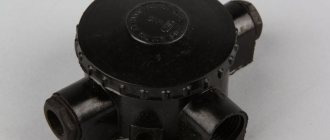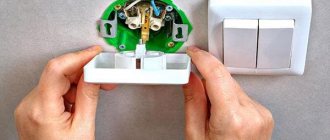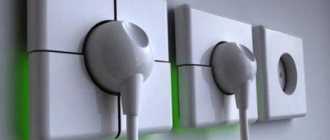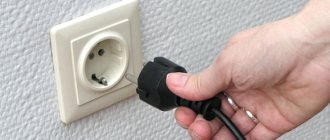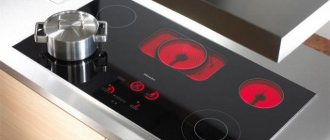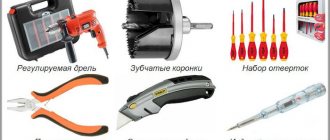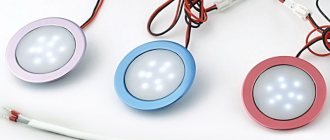This information may be useful to anyone who has ever encountered or will encounter the installation of socket boxes. We will describe as briefly and concisely what a socket box is , how to install it correctly and how much its installation may cost. You will also learn how to put back a fallen socket and what can be used instead.
- Installation Rules
- Socket sizes
- Installation in concrete
- Grilling
- Installation in drywall
- The socket doesn't stay in place
- Installing socket boxes in tiles
Remember three basic rules for a quality installation:
| Rule #1. A correctly installed socket box should not protrude or be too recessed into the wall, that is, it should be built flush with the finished wall. A finished wall is considered to be a wall that has already been prepared for painting. We will consider cases when it is planned to lay tiles or some other false panels on the wall below. |
| Rule #2. Socket boxes must be installed strictly level, even if there is only one socket box, it must be set level to avoid difficulties in the further installation of sockets or switches. |
| Rule #3. A correctly installed socket box should hold very tightly in the socket. |
You can also add a few nuances that will help you understand what kind of electrical outlets you need; how to prepare holes (sockets) for them; how to properly insert a cable into a socket box; and how to install it correctly.
Installation of socket boxes in ceramic tiles
If it is necessary to install a socket or switch in a wall that is supposed to be tiled, marking and making holes in the concrete should be done before finishing work begins. Electrical wires are laid in advance in the resulting recesses.
After laying the tiles, markings are made again and holes of the required depth are drilled in it. It is best to drill the tile with a diamond core bit, periodically cooling it with water.
A gypsum solution is placed in the recesses, it is also applied to the back of the socket box, and then the box is pressed into the hole and leveled.
To install several sockets, a template is made in advance, according to which the wall is marked
Socket sizes
Everything about the size of the socket boxes is simple, the most common size of the socket box is 70mm in diameter. In the vast majority of cases, they all have the same size. And most modern sockets and switches are designed specifically for these sizes.
Types of socket boxes
It is important not to forget about such a parameter as the depth of the socket box . But even in this case, everything is simple, if you plan to connect several wires in the socket box, in addition to the socket or switch itself (for example, use a socket box instead of a junction box), then you will need a deeper socket box. If possible, use deep socket boxes; they are then easier to work with and install sockets in.
Switching wires in a socket box instead of a junction box
Remember! - Once installed correctly, the socket box never reminds of itself again.
Types of socket boxes according to installation method
When choosing an installation box, several factors are taken into account. You should pay attention not only to the material of the product, its shape and type of construction, which can be single, double or triple (there are even row ones). The type of installation (vertical or horizontal), as well as the material of the wall where the installation will be carried out, also matters.
Glasses can be installed in the following types of surfaces:
- solid walls;
- plasterboard partitions;
- baseboards.
Important! The dimensions of the crown for the socket box, as well as the size of the glass itself, are selected taking into account the type of surface. Each material has its own requirements for system parameters, so the technology and set of tools may vary.
For different wall materials, the appropriate type of mounting box is selected
Solid walls: dimensions of socket boxes for concrete and other materials
If you intend to install communications in solid walls, experts recommend using the bricking method. This method is applicable to rooms where partitions are made of aerated concrete, brick, concrete, stone and other materials with a similar structure.
Since solid walls are quite thick, there are no strict restrictions on the depth of concrete sockets, their shape and structural structure. However, there is a single standard diameter - 68 mm. Moreover, this indicator is not a requirement of the material itself, as such.
Motion sensors for turning on lights: a sure way to save energy
Device characteristics. Varieties of devices according to different criteria. Sensor installation algorithm. Popular models. Lamp with DD.
Concrete wall panels have generally accepted parameters. They are cast together with recesses for mounting sockets and channels where the power cable is laid. There are clear building standards for the manufacture of concrete wall panels, and the specified diameter of the socket box is already a by-product of these rules. For solid walls, boxes with a depth of 41-45 mm are usually taken. This is quite enough to efficiently install any type of sockets and switches.
If you do not take into account load-bearing walls, the thickness of the partitions in the room is 8-10 cm minimum. Design of food outlets is usually carried out at one level. Thus, the sockets will be located on both sides of the wall. In addition, they will be powered from the same power cable. This means that the total depth of both boxes should not exceed 9 cm, that is, no more than 45 mm for each.
Installation of socket boxes in a concrete wall
Why is deep socket boxes installed in concrete?
Deep glasses are mounted in load-bearing walls. The thickness of these partitions allows you to install not only standard products, but also boxes with increased parameters. Installation is carried out using the same crown for 68 mm socket boxes, since the diameter of the glasses remains the same.
Deep mounting boxes are used for various purposes. Firstly, they are suitable for installing sockets for a television cable or an Ethernet local network. The bending radius of the inner wire in this case should be quite large. Conventional glasses do not provide such conditions, so the planting depth must be increased to 61 mm.
Secondly, a box with an elongated body allows you to install volumetric elements. These include sockets with a non-standard module or switches. All the filling will easily fit inside thanks to this extra 15-20 mm.
Thirdly, increased depth is necessary for glasses that have a dual purpose. These products are called two-tier. Thanks to them, the finish looks more aesthetically pleasing, and manufacturers can save on the amount of material.
Note! Two-tier glasses are suitable not only for sockets, but also for switches.
For installation in load-bearing walls, deep glasses are most often used
Socket boxes for drywall: product sizes for thin partitions
Ordinary glasses for solid walls are not suitable for installing sockets in drywall. For these partitions, special designs with a special structure are provided. To indicate the size of the boxes, the outer diameter of the products (d2) and their seating depth (H) are used.
Especially for working with thin partitions, a standard diameter of socket boxes for plasterboard is provided, which is 68 mm. Although there are other options on sale. The outer diameter of these products can be 75, 70, 65, 64 or 60 mm.
The depth of installation boxes may vary. In small products it is 40, 42 or 45 mm. There are also deeper types of glasses. Their size can be 60 or 62 mm.
Models with non-standard fit dimensions are supplied to markets. Such products do not comply with the norm; rather, they are exceptions to the rule. When choosing a glass, you must take into account the installation location. Experts recommend using boxes with a landing depth of 60 or 62 mm, if the thickness of the plasterboard partition allows this. Such designs greatly simplify wiring installation if the circuit does not allow the installation of junction boxes.
The diameter of cups for plasterboard walls can vary between 60-75 mm
Installation boxes for mounting baseboard sockets
Installation boxes for mounting sockets in baseboards are produced in the form of ready-made modules. Their parameters are adjusted to the generally accepted standard. You don't have to worry that sockets or other switching devices won't fit. These products have a special configuration, due to which they are installed on top of the baseboard. The back part is attached to a load-bearing wall or drywall.
The shape and color of these products may vary. To ensure that the installation box does not attract attention and does not stand out from the overall picture, it is advisable to select colors in accordance with the decoration of the walls and the design of the outlet itself.
Installing such boxes is as easy as installing surface-mounted sockets. To do this, you need to create a small gap in the baseboard. Its size should correspond to the size of the back of the box. The width of the fastening part varies between 65-85 mm. The maximum depth of such a glass is 25 mm. The power cable should be laid into the channel and the box should be screwed to the wall using screws.
Important! You need to make sure that the socket box is firmly and securely attached to the wall. Otherwise, this module and its contents will be torn off every time the plug is pulled out of the socket.
Installation of boxes for baseboard sockets in a brick wall
Composite designs and triple sockets in one socket box
Triple sockets come in many configurations. There are models enclosed in one frame and having one lid. There are options on sale with three separate sockets. In this case, the body and cover are combined. Models equipped with a switch are in high demand among consumers. It allows you to de-energize a certain section of the circuit, which is very convenient for those cases when the owners of the apartment are absent for a long time.
Triple socket boxes are used for mounting two types of sockets:
- C5 is a Soviet-style socket. It does not have grounding; in some cases, the holes for the plug have a non-standard appearance.
- C6 – Euro socket, with or without grounding. The dimensions of these devices are subject to a strict standard.
To install boxes with three separate sockets, you will have to additionally drill two holes. There are no problems with a plasterboard partition: the appropriate diameter of the crown for the socket is selected, markings are applied taking into account the center-to-center distances, and further actions are carried out in accordance with the technology.
To install several sockets in a row, elongated and composite glass designs are used
Installing the box in solid walls will entail additional costs. Therefore, many apartment owners prefer to install a triple socket in one socket box. This option is considered cheaper, although it cannot be called practical.
Installing a socket box in concrete
What needs to be done to install a socket box in concrete? Right! - Make a hole under the socket box! For this, it is best to use a drill with a diamond bit, but this is not the best option in terms of cheapness. A more convenient and practical option is a hammer drill with a concrete impact bit, or simply cut out the concrete with a grinder and a stone disc (but this is a very dirty method, and dust will be absolutely everywhere: in the ears, eyes and in the entrance).
It should be noted that when gating, a lot of fine dust is generated in the room, and first of all, installers should take care of their health and purchase standard protective equipment: masks, respirators, headphones and a construction vacuum cleaner.
Future holes must first be marked. We draw a line along the level and place marks on the wall. If you have 2 or more socket boxes, then the distance between the centers of the circles is 71 mm . This is a distance calculated empirically by professional electricians, tested with sweat and blood! Remember 71mm!
The easiest way to make marks is to attach a group of sockets to the wall.
Hole cutting
After marking, in the marked centers of the circle it is necessary to make a hole using a drill with a slightly larger diameter than the crown drill (for example, an 8-10mm drill). We drill a hole with a margin, taking into account the length of the drill bit of the crown itself (but do not forget about neighbors and thin walls). This method is also suitable when working with a diamond core bit in drilling mode.
The process of gating. After drilling holes in the center of the future circle, you need to use a crown to go deeper into the wall a few millimeters (this only applies to the method of working with a hammer drill!). Along the intended circle, you need to drill the maximum possible number of holes to make it easier for the crown to “gnaw” the concrete.
With a diamond crown, you just need to drill - without chiselling, periodically letting the crown cool. It is worth noting that if a diamond bit gets on the reinforcement, its service life is significantly reduced.
When working with an angle grinder, the whole task comes down to making cuts in the wall to the required depth and hollowing out the area where the socket boxes will be located.
Installation of boxes in concrete and brick walls
For the diameter of the socket boxes, there is no clear regulation on which partition they should be placed in. The value of 67-70 mm is equally suitable for any socket, and even more so for the cross-section of a diamond crown.
Before forming the nest, you need to dismantle the section of wallpaper (if the installation is already completed) and apply markings to the panel. Then the crown is attached to the hammer drill, its axis is set clearly in the center and drilling is performed. In this case, the tool must be held strictly at an angle of 90 degrees with respect to the wall. During drilling and sampling of concrete, it is necessary to adjust the socket so that the depth of the socket box corresponds to it. The best option is considered to be one in which the round edge of the installation box is located flush with the wall. All this is measured to the building level.
When forming a nest in a brick wall, the drilling principle looks the same. The only difference is the depth of the nest. The installation box must be mounted in such a way that its edges fit perfectly with the finishing of the brick walls. And this could be sheets of plasterboard, clapboard paneling, plaster, etc. It would probably be more correct to use a deep socket box here. The main thing is to calculate the thickness of the finishing layer. If this is difficult to do, it is better to carry out drilling after relatively finishing work.
What to do if, while drilling, a drill or bit gets into the reinforcement?
There are several ways to remove rebar. One of the fastest and most painless is knocking out the reinforcement with a chisel - an attachment for a hammer drill. If the crown gets into the reinforcement (an indirect sign of it getting into the reinforcement is sparks or a clear slowdown in the drilling process), it is better to remove this reinforcement, otherwise you will ruin the crown.
The second less convenient way is to use an old crown. It doesn’t matter which way you do it, with a diamond or a drill bit, in both cases we simply drill out the reinforcement. The reinforcement metal is very soft and can be easily broken through with a hammer drill. And the third, dirty way, is to simply drill out the reinforcement using a grinder with a diamond disc on the stone.
Installation on a wall with tiles
If the box is installed on a tiled wall, the diameter of the hole for the socket remains standard - 68-70 mm. Experts recommend making a nest before laying the tiles. Here, markings are first applied to the panel and to the selected tile block. First they make a nest in the wall. Its depth is initially not made very large, since it will increase due to the tiles laid on the glue. And this is an additional 1.5-2 cm.
The tiles are drilled on the floor, laying a special shield made of wood or plasterboard. To cut tiles, you can use a hammer drill with a diamond crown, a hand saw or a jigsaw with a tungsten thread, a ballerina, or pobedit drills. The smoothest cut is obtained when working with nibblers or a hammer drill attachment. Before performing work, it is advisable to soak the ceramic block for an hour in cold water. This enhances the strength of the material.
If the wall is already tiled, the cut should only be made with a crown.
It is not advisable to place a socket at the junction of two or four tiles. When forming a nest in this way, the strength of the ceramic decreases. Tiles on the wall may crack.
Embedding a socket box in concrete
The best way to secure socket boxes is to embed them in the hole using alabaster or rotband. A small life hack - so that the solution does not harden too quickly and you do not have to wait a day - you need to mix alabaster with rotband.
First, use a vacuum cleaner to remove all dust from the hole and moisten (prime) the hole with water. And only after this, we apply the solution with a small spatula, spreading it along the inner walls of the hole. The solution should be thick enough not to leak out of the wells. It is important to understand that the area of contact between the solution and the socket box should be maximum! Plus, coat the socket boxes themselves with the mixture. The solution will envelop the socket box from all sides and adhere well to the base of the wall, only then can we say that the socket box is installed efficiently!
Using a large spatula, remove excess mortar while leveling the surface of the wall. Before this procedure, it is necessary to remove or screw in all the screws of the socket box.
https://www.instagram.com/p/CU3DCTZqssQ/
Laying the cable in the socket box. It is best to lay the cable in an already installed socket box; the windows for the cable are easily knocked out with a screwdriver, and it is better to make channels for pulling the cable between the socket boxes in advance. When the solution has cooled, you can safely insert the cable into pre-made holes or recesses.
If you don’t have that much time and the cable needs to be installed together with the socket box, try to align the socket boxes as accurately as possible. You can insert the cable into any hole, but it is better not to use the side windows for this, so that there are no difficulties with the subsequent installation of sockets.
Important! The entry of the cable into the socket box should not in any way interfere with the future socket, especially from the side of the spacers. A very common mistake when installing socket boxes is to break the wires with a spacer from the socket - in this case, a dangerous potential may appear on the socket body, or a short circuit may occur when the electricity is turned on.
Types and characteristics of socket boxes
Modern sockets in appearance and installation method differ significantly from those installed in Soviet-era houses.
If previously they were simply embedded in the wall without the possibility of replacement, today installing them and, if necessary, changing the socket is not particularly difficult.
A socket box is a mounting device designed for reliable fastening of electrical installation products for hidden wiring.
Yandex.RTB RA-1479455-2
Regardless of whether the installation of a single or a group of socket boxes is carried out, before their installation, the walls are chipped
When buried in a brick or concrete wall, these mounting boxes or glasses are secured with alabaster
The socket box is fastened to partitions and false walls made of plasterboard using adjustable spacer legs
Almost all building materials and slab options used in rough wall cladding are suitable for installing socket boxes in them
In the line of products for hidden wiring you can find options for arranging log and timber buildings
Socket boxes are used for installing single switches, power points and socket blocks
During operation, it is easier to tighten the “loose” mechanism in the socket box. With its use, installation is carried out faster and more accurately
Yandex.RTB RA-1479455-7
Selecting a socket box based on wall material
The main selection criterion is the material of the walls into which the socket boxes will be installed.
On this basis, there is the following classification of boxes:
- structures intended for installation in walls made of solid materials: concrete, reinforced concrete, aerated concrete, brick;
- glasses for walls made of composite materials: plasterboard, plastic boards, chipboard, plywood and others.
In the first case, the socket box is a round glass without any additional elements. It is fixed to the wall using mortar.
There are mounting holes in its walls or bottom for electrical wiring. When installing a socket box, it is enough to remove the jumpers and push out the plug.
Socket boxes with side docking units allow you to quickly and easily install two or more sockets at once
Yandex.RTB RA-1479455-3
To install several sockets located nearby, you can use glasses, on the side of which there is a fastening mechanism. The socket boxes are connected to each other using special grooves and combined into blocks.
Drywall boxes contain special plastic or metal clamping tabs designed to secure elements into hollow walls. The clamps are attached to screws, which rotate to adjust their position.
When the screw is turned, the foot rises or lowers. Clockwise rotation brings the clamping element closer to the wall and secures the glass in the drywall
Yandex.RTB RA-1479455-8
What shapes are the products produced in?
Round socket boxes have become most widespread. It is very easy for them to make a hole in the wall using a variety of tools.
Round glasses can be used both for mounting a single socket or switch, and they can be combined into groups, connecting to each other using docking units.
Square boxes, although not used as often, have certain advantages. Their volume is much larger, so you can hide a lot of wires in them.
They are often used to install elements of the “smart home” system. There are single and group square-shaped socket boxes designed to install up to five sockets.
There are also oval boxes on sale, which, like square ones, have a large internal space. They are convenient because you can immediately connect a double socket to them. All the products described above are mounted in walls and used for hidden wiring.
There is another type of mounting boxes that stand somewhat apart - plastic linings or multiboxes, designed for open installation on the baseboard. They are designed for one or more outlets and are usually square in shape.
This type of installation of plastic overlays can only be used on dismountable plastic skirting boards
External socket boxes have two modifications - designs with installation to the middle of the baseboard or to the floor. Since multiboxes are mounted on top of the baseboard, their distinctive feature is their aesthetic appeal and original design.
Installation box size
An important parameter of socket boxes is their dimensions, which are selected based on specific installation conditions. The fork dimensions are 60-70 mm in diameter and 25-80 mm in depth.
Standard designs have external dimensions of 45 x 68 mm, but it must be taken into account that the internal depth in this case will be 40 and the diameter 65 mm.
When installing several round socket boxes in a group, one of them, which has an increased depth, can, in addition to its main purpose, serve as a distribution box
Glasses of increased sizes, the depth of which is about 80 mm, are advisable to use when there is no distribution box in the electrical wiring, and its functions are performed by the electrical outlet itself. As for square products, as a rule, they have a size of 70x70 or 60x60 mm.
Material for making mounting boxes
The most popular are socket boxes made of non-flammable plastic. They can be installed in concrete walls and structures made of composite materials.
There are also metal boxes, which were used everywhere in the past, but today they have almost been replaced by plastic products.
Metal socket boxes are usually installed when installing electrical wiring in wooden houses. They are made of galvanized or non-ferrous metal and cannot be welded, so the connection to a metal pipe is made by soldering.
For safety reasons and fire prevention, when installing electrical wiring in wooden houses, it is necessary to use metal socket boxes
At what stage of repair (finishing) is it better to lay a socket box?
This is one of the most pressing issues that not everyone thinks about at the beginning, but understands how important it is in the end. Ideally, you need to follow RULE No. 1 , but this does not always work out.
Therefore, you need to know in advance how much the layer of plaster or other layer (plasterboard, tiles, etc.) will protrude before installing the socket box. As a last resort, you can break this rule and install the socket box flush with the bare concrete wall. But in this case, when plastering the walls, the socket boxes will be recessed into the wall, to the depth of the plaster layer. It will not be easy to properly install sockets in such a socket box, but our electricians know how to do it correctly.
How to choose an installation box
When purchasing a socket box, you need to pay attention to the following parameters:
- Purpose: in which wall the sockets will be installed (in concrete, brick, plasterboard, wooden panels, etc.).
- Depth. This parameter is especially relevant if the master intends to install two parallel sockets on one wall on both sides. Here it is worth paying attention to shallow glasses of 25 mm.
- Form. The round one is considered the most popular. If the master deals with non-standard power points, there is a reason to use square boxes.
- Type of block socket boxes, method of connecting them into one panel. Sometimes socket boxes are connected with specially purchased connectors. But it’s good if the product already has special slots for fastening.
- Product wall thickness. The larger it is, the less susceptible the part is to melting and burning. There are varieties of glasses on the market for this parameter from 2 to 4 mm.
Price and manufacturer are not the most important criteria when purchasing an installation box. The consumer prefers to buy products from Kaiser (Germany), Courbi (Greece), SEZ (Slovakia), Schneider-Electric (France) or Kopos (Czech Republic).
Installation of socket boxes in gypsum board
When working with drywall, the cable is laid in advance or pulled through using technical holes and broaches. In the places of future switching (connections) of the cable, or in those places where there should be a socket box, leave a supply of cable, and mark outside where this cable is located. Mark the location of the future hole for the socket box in any way convenient for you, for example, screw in a self-tapping screw in this place.
Markings for socket boxes are made in the same way as markings on concrete. The distance between the centers of the circle is the same 71mm . It is important to consider that a drilled hole cannot be fixed (or rather, nothing is impossible for a good electrician), but before you call an electrician, you need to try to do it yourself.
Holes in drywall can be made with a regular wood bit, 68mm , using a screwdriver or drill.
After drilling the hole, you need to find the necessary wires, which should be right behind the wall. It happens that they are hidden in a junction box, or hang on a cable, with the help of which the wires can be pulled to the hole. Each master has his own way of pulling wires into hidden cavities, but that's a different story.
You need to insert the wires into the socket box BEFORE installing the socket box itself, otherwise it simply cannot be done.
Now comes the fun part. The most painful procedure is the correct installation of the socket box in the drywall. This is due to the fact that different manufacturers of socket boxes for plasterboard (or wood) have lugs for securely fixing the socket box to the ceiling wall (plasterboard, plywood, or whatever you have). In some cases, because of these ears, the rosette does not fit into the prepared hole, but this problem does not occur on all rosettes!
It is best to take care of this in advance when buying socket boxes. Make sure that the ears, when open, do not go beyond the circumference of the socket itself, for example, like here
If, nevertheless, you manage to buy the “wrong” socket box, then you can use one little trick: eyelets are made in plywood or drywall at a slight angle (it is enough to make them only on one side), after which the socket box can be installed normally. The socket box should fit into the hole normally at an angle. The main thing is not to overdo it and not to make a hole with a larger diameter than the outer edges of the socket box.
After all the procedures, we fix the socket box by tightening the screws
How to choose sockets for an apartment, house, office
We will also recommend an algorithm for choosing suitable electrical accessories for this stage.
The first thing to consider: modern manufacturers produce electrical installation products both assembled (less commonly) and disassembled. The photo below shows sockets and switches, VIKO Karre
The dismountable package includes a socket mechanism with a metal frame (attached directly to the socket box) and a decorative frame. This is what Legrand's socket and switch mechanisms look like:
And there are simply countless options for decorative frames for the mechanisms of sockets and switches, only in this online store look at the frames, both single and triple, and in the style of cubism and even modern material design - 1970 different frames.
Don’t forget that, even if you buy everything in advance, decorative frames are placed at the finish line of the renovation, after wallpapering or painting the walls.
Of course, the second option provides ample combination possibilities.
Keep in mind that in frankly cheap series, the metal support frames do not have grooves and may become slightly (or significantly) skewed during installation. As a result, the decorative frame may not be as desired and will have to be redone.
And good series are equipped with special grooves that prevent deformation.
Have you decided to use the progressive “mechanism plus frame” technology? Then pay attention to the following points:
- Frame material. We have already mentioned that plastic ones are the cheapest, and the majority of them are on sale. Natural materials like glass, stone, metal or wood are much more expensive, but sometimes they look much more appropriate and impressive (for example, for stone walls). You can choose more impressive frames for several points located in strategically important places in the apartment.
- Frame design. Here you can afford almost everything. Subtle shades or bright colors, classic or innovative shapes, retro chic or futuristic notes. You'll have to rack your brains, and collections from leading manufacturers will help you. We will write in more detail about the choice of design of electrical installation products below; it would be useful to pay special attention to this issue.
- With or without grounding contact .
- With additional elements: curtains (the holes will open only when one force is pressed at the same time, i.e. only for the pins of the plug) - protection against unauthorized children's experiments, or with covers.
- Sockets with claws are a separate story, relevant for those who want to replace electrical fittings in a deeply Soviet-built apartment. The old socket box is wider than the modern ones and is not “tailored” to fit the current sockets; their screw fastenings simply do not match. In these cases, you will need a socket with claws (steel in the design), or you will have to purchase claws separately.
The main recommendation is to look for “yours” only from serious manufacturers of electrical accessories. To be calm about the quality. Moreover, in large stores it is easy to choose something suitable both from the range of famous European brands and in the economy segment (for example, Turkish brands).
But perhaps the most interesting and creative thing is choosing a design. We will devote a separate paragraph of the article to this task.
How to choose sockets for your interior
It's easiest for those who are visually satisfied with white or ivory plastic - there are a lot of such offers. And if you want to make sockets and switches an organic part of the aesthetic design of your home or apartment, be prepared to spend time and make mental and creative efforts.
Modern trends make full use of several basic ideas:
- modularity (the ability to assemble several sockets and switches in one multi-place frame);
- variety of not only the palette of shades, but also textures;
- simplicity of lines and laconic forms (although gold monograms, if necessary, can be found in the collections of leading manufacturers);
- noticeable influence of naturalistic and industrial style.
To get maximum choice and be confident in quality, pay attention to electrical installation products from industry leaders. The Unica series from Schneider Electric, Berker from Hager, Valena from Legrand give maximum freedom to lovers of design and creative experiments.
But this endless variability of lines and models also has a downside. You can spend a lot of time choosing “those” frames for your wallpaper.
Therefore, do not rush to start visiting construction hypermarkets. Firstly, you will waste precious hours wandering along kilometer-long shelves. Secondly, the main assortment in retail trade is represented by universal (read: boring) solutions.
Take advantage of our technologically advanced times. At a minimum, check out the offers in online stores. To be fair, we note that only a few resources create a truly informative and convenient catalog, maintaining a decent assortment. Only large and established retail outlets can do this. Some have gone even further, offering visitors truly useful functionality.
I would like to note the Axiom Plus store catalog for two really useful features:
- a detailed catalog with the maximum possible number of selection parameters (technical and aesthetic);
- quite possibly an exclusive option in the electrical accessories configurator. Right here you can upload photos of purchased (or selected) wallpapers and directly substitute all possible rosette options from the catalog against their background. Without leaving your seat, you try on shades and shapes from different collections on your own wall. And then place an order for the ones you like. Bomb!
What to do if the socket box pops out of the wall
In cases where you are faced with a dropped or poorly secured socket, there are several ways you can correct the situation. The simplest and most reliable is to screw a self-tapping screw into the base of the socket box (if it is concrete, a self-tapping screw with a dowel). The second method is to use a glue gun. Before gluing, it is necessary to remove all dust from the hole. More complex situations, when, for example, the base is gypsum and it crumbles. A plaster solution will help here ; the base must first be primed, for example with PVA glue.
The mortar method can also be suitable for plasterboard structures. In general, the solution is, in principle, a panacea for fallen socket boxes. In some severe cases, you can screw the socket or switch itself to the base of the wall.
Installation of socket boxes in tiles or wall panels
It is better to lay the cable and install the socket boxes in advance, before laying the tiles. But if the tiles are already there and you need to make an outlet or switch, then crowns for ceramic tiles will help. The drill bits will help you carefully drill holes in the tiles.
The hardest thing is if there is concrete under the tiles that needs to be tapped. In this case, it is best to use a diamond crown, otherwise there is a chance of damaging the tile (when chiselling with a regular crown).
There is a cheaper and dirtier way, this is drilling a hole with a grinder, the main thing is to drill everything out as carefully as possible so that the hole is covered by the frame from the socket.
Diameter
For round boxes for concrete, manufacturers have developed a different classification system:
- Diameter of the socket . Denoted by the letter D. The most popular parameters: 60 , 64 , 65 , 68 , 70 and 75 mm . In order for a socket or switch to fit perfectly inside the casing, it must have a similar mechanism diameter.
- Depth . Denoted by the letter H. Typical sizes: 40 , 42 , 45 , 60 and 62 mm . There are products with a depth of up to 80 mm . They are needed for internal placement of terminal blocks if the wiring is not equipped with junction boxes.
When installing oval and composite socket boxes, it is necessary to take into account such a parameter as the center-to-center distance - the “distance” between the centers of the axes.
This is the distance that needs to be measured between the drilling holes when installing the box. According to the standard, it is equal to 71 mm , but some are larger or smaller.


